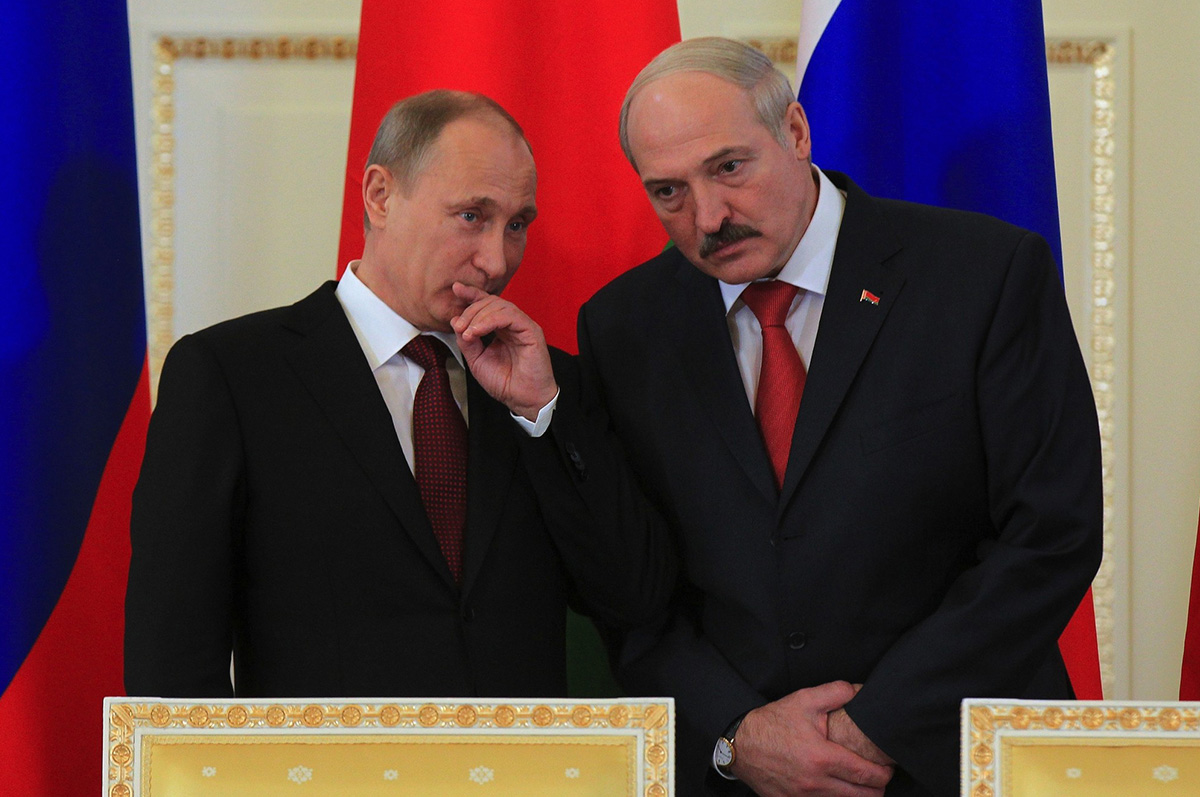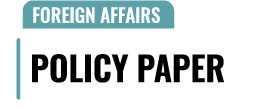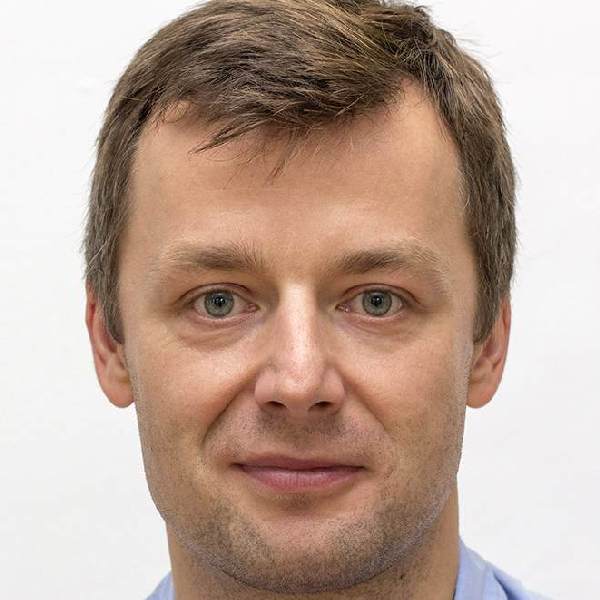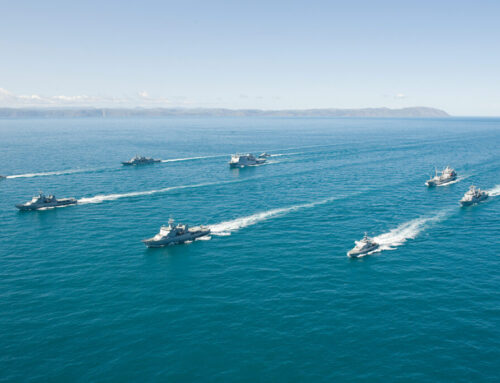Pulaski_Policy_Paper_JC_RB
Autor foto: Domena publiczna

In the shadow of “Zapad 2017” – issues in Russia-Belarus relation
September 29, 2017
Author: Jędrzej Czerep




Pulaski_Policy_Paper_JC_RB
Autor foto: Domena publiczna
In the shadow of “Zapad 2017” – issues in Russia-Belarus relation
Author: Jędrzej Czerep
Published: September 29, 2017
Pulaski Policy Paper no 21, September 29, 2017
Between September 14th and 20th 2017 Armed Forces of the Russian Federation executed a series of military manoeuvres in a number of training grounds located in Belarus, themselves a part of the Zapad-2017 exercises. Remaining exercises were held in Russia – in Pskov, Leningrad and Kaliningrad Oblasts. Preparations for exercises lasted a couple of months, and were not accompanied by a satisfactory amount of information, giving rise to speculations, whether the Russian forces will return to their original places of dislocation once the Zapad manoeuvres are concluded. Fears, that Russian units will remain deployed in the territory of Belarus permanently were exacerbated by the recent conflict in Ukraine, as well as resurgence of imperial and nationalistic rhetoric in Russia. The aforementioned narrative emphasises Russia’s right to recoup territories it lost after dissolution of the USSR. States sharing a border with the Russian Federation, that are also a home to a significant Russian speaking minority are the most threatened by this approach – apart from the Baltic states, Northern Kazakhstan and Belarus also fit the bill.
When evaluating the importance of manoeuvres for Belarus and more generally the state of Belarus-Russia relations, one should keep some fundamental constants in mind, including:
- That Lukashenko is well aware of the fact, that his survival hinges on Belarus retaining its independence. Paradoxically, this puts him on the same page with the opposition that grew out of the Belarusian national revival movement;
- That the extent to which Belarussian state structures including armed forces, is penetrated by the Russians is so significant, that one could hardly speak of any real separation between those two states;
- The cyclical nature of rivalry over Belarus between Russia and the West, a rivalry which Belarus meticulously exploits in order to obtain benefits from either side. The recurring tensions are oftentimes a calculated measure, meant to gain extra leeway, courtesy of either the West, or Russian Federation.
The place of Belarus in Russia’s relations with the West
The strategic location of Belarus, located on the shortest lowland route leading to Poland and Western Europe is of key importance to Russia (historically, the Napoleonic and Nazi armies en route to Moscow passed through the region, including the so-called Smolensk Gate). Today, Belarus’ western border serves as Russia’s westernmost outpost (not including the exclave of Kaliningrad).
Belarus is also the most important transit country for Russian hydrocarbon exports headed West (especially the Yamal-Europe gas pipeline and the northern part of the Druzhba pipeline). Minsk traditionally occupies a central role in the game Russia plays with NATO and the EU, particularly in its military and economic dimension. Russia perceives the EU’s rapprochement with Belarus as an encroachment into its sphere of influence, and is willing to actively prevent it from progressing too far. After several years of the EU maintaining its economic sanctions (imposed as a result of opposition crackdown following the 2010 elections), most of them were abolished in February 2016 (a few months earlier similar change in rhetoric started to come from Washington). The assessment was, that Belarus has sufficiently improved its human rights record, and EU entrepreneurs should be allowed to do business in Belarus again. Poland has also altered its policy towards Minsk at that time, in favour of a more active and accommodating one. Lukashenko’s role in brokering a ceasefire in Eastern Ukraine also played an important role in improving Belarus’ current standing in the international arena – he maintained good relations with the new Ukrainian government and the Kremlin, allowing to present himself as a credible partner and able negotiator in the post-Soviet zone.
The specificity of Belarussian armed forces
While Belarusian state institutions maintain a limited level of constitutionally mandated bilingualism, Belarussian armed forces remain completely Russified: all documents and commands are issued in Russian. The Union State of Russia and Belarus permits Belarusian military personnel to pursue a career in the Russian armed forces after completing their conscription, what is a popular career path for Belarusian soldiers. Russia and Belarus are developing a common anti-aircraft system, which will formally subordinate Belarussian units to Russian command. Majority of high ranking Belarussian officers begun their careers in the Soviet army, are mentally a product of the Soviet propaganda, and consider Russian armed forces as “their own”. Due to the perpetual underfunding of Belarussian armed forces, Russian provisions are indispensable for day to day functioning of the Belarussian army. Those extremely tight links between Russian and Belarussian military mean, that a hypothetical military intervention by Russia may well prove to be redundant – Kremlin may effectively pursue its policies in Belarus without it.
The sharpening of rhetoric, symbolical gestures
Starting in the second half of 2016, a number of consequential symbolic gestures were made, heralding a possible deterioration in the Russian-Belarusian relations. For the first time Belarusian authorities took limited, but decisive steps against the most aggressive representatives of the Great Russia movement, who openly question Belarusian state and sovereignty (on a side note, those same Great Russian circles are frequently critical of the Kremlin because they consider it not nationalistic enough). Up until recently Minsk demonstrated a high degree of tolerance towards extreme pro-Russian circles, “Russian Mir” supporters, or Belarusian citizens fighting for the rebels in the Ukrainian Civil War (no such leniency was granted to those who sided with the pro-Ukrainian forces).In November 2016, an Orthodox priest Konstantin Burkin was detained in Belarus due to his links to the extremist organisation known as the Russian National Unity, while in December 2016 three creators of the Regnum webpage (one of the most important propaganda outlets in the post-Soviet area, representing extremely pro-Russian positions) were arrested. In January 2017, Minsk’ Central District court designated the content posted on Sputnik and Pogrom website as extremist and ordered it to be shut down. Sputnik and Pogrom gained notoriety after it broke the news about the arrest of Eduard Palchys, a contributor to 1863x.com webpage (name is a reference to the anti-Russian 1863 January uprising), and published pictures of Palchys, taken in jail where he was held (most likely obtained directly from the Briansk jail personnel, indicating that the administrators of the page were well connected with the Russian security agencies). Last August three individuals arrested in 2016 were charged with inciting hatred. In doing so Minsk has proven that there is a finite extent to which it can tolerate pro-Russian agitation – a clear departure from the previous position held by Minsk. Those actions were condemned as rusophobic by mainstream Russian, and labelled a threat to the well-being of Russian speaking Belarusians. In April last year media outlets such as life.ru, Moskivskij Komsomolets, or mk.ru decried the release of a new Belarussian collectors coin decorated with the image of the city of Mogilev, and with the words “Pora! Pora! (it’s time), that were uttered in 1661 by the major of the city in his address calling for rising against Russian garrisons. The aforementioned incidents gave rise to believes, that at their core they are caused by a major conflict, one caused by Belarus being weary of potential Crimea and Eastern Ukraine type developments. Even though unprecedented, those events still are of marginal importance as far as bilateral relations go. Furthermore, they relate mostly to independent initiatives, and thus do not translate or impact bilateral state relations directly. The beginning of 2017 has also brought about tightening of border restrictions between Russia and Belarus. Traditionally, the border between these two states was considered to be an internal border of the Union State, and passports were not required from neither Belarussian nor Russian citizens. It is also an established smuggling route for products that are currently subjected to sanctions (including Polish apples, or western made products repackaged in order to pass for Belarussian, including the famed “Belarusian shrimps”). Even before the end of 2016 Russia announced, that it will cease to allow entry to third country nationals arriving from Belarus. In February 2017 Russia announced its intent to reinstate the border zone in the Smolensk region. Both of those decisions served to demonstrate Kremlin’s displeasure with Belarus loosening travel restrictions with the west (visa free entry to Grodno, Augustow Canal and Bialowieza Forrest) as well as introduction of a five day visa free regime for persons arriving at the Minsk airport. The latter led to Russia and Belarus reclassifying flights between the two countries as international, reverting the previous domestic designation. Moscow is of the opinion, that loosening the travel restrictions will threaten an uncontrolled influx into Russia. Reinstating borders between Russia and Belarus has, apart from practical significance, a psychological dimension.
An interrupted thaw
Beginning of 2017 brought about an unprecedented thaw in Belarusian cultural life, first of such kind since 2010. Its most significant touchstone was a marked attitude change of the authorities towards Kuropat massacre – a Belarusian equivalent of Katyn. In the 1930’s the Soviet secret police NKVD carried out mass executions of anti-Soviet political dissenters, in the heavily forested area near Minsk. No bodies were exhumed and it is estimated, that the site may still hide the remains of over 200,000 people, including many of the Belarusian cultural and political elite. The murders have never been thoroughly investigated, and the authorities have blocked all attempts to erect a memorial site in the area, presumably because such action would diverge from the “official party line” in terms of historical policy. The administratively designated protection zone has been reduced many times. Protests erupted when heavy equipment entered the area of Kuropat near Miroshnichenko Street, in order to begin construction of an office complex, with activists trying to halt the work in that particular location. In a surprising turn of events, the developer who bought the land four years prior, announced that he understands the qualms of the protesters, does not wish to violate the protection zone and subsequently completely withdrew the construction equipment from the area. Building up on the governments positive reaction to the commemoration of the Kuropat site (which was a taboo subject up until then), an exhibition entitled “The truth about the Kuropaty” was held in the Minsk Palace of Art, while president Lukashenko announced a contest for designing a monument commemorating the massacre, one that could potentially become the city’s landmark. Nobel Prize laureate Svetlana Alexievich (who previously was consistently ignored by the Minsk authorities) was invited by the presidential administration to join the supervisory board. Although the opaque nature of the competition seems to suggest, that it was merely an attempt to control the historical narrative, the mere fact of publicly recognising a site of NKVD massacres as deserving commemoration must be considered noteworthy. A good illustration of the scale of “opening” of authorities in this regard is the fate of a feature film about Kuropatów, based on a novel by Vasil Bykau entitled “Yellow Sand”. Even though the director covered most of the production costs (the authorities refused to provide any financial support) and the actors were not compensated for their work, the picture was approved for limited distribution, and was set for release in October 2017. It would be an overstatement to take this for a sign of a substantial change of attitude, yet as far as the reality of Belarusian oppositions’ relations with the central government is concerned, the progress is clearly noticeable. At the end of 2016, the re-release of an iconic “Narodny Albom” musical grabbed the attention of Belarus’ cultural elite. The musical tells the story of inhabitants of a small town situated along the pre-war Polish-Soviet borderland (present-day Western Belarus). Polish owned satellite TV station Belsat led the initiative, granting the Belarusian public with an opportunity to see the artists “black listed” by the regime. In what must be defined as an unexpected turn of events, the Belarusian authorities invited the artists to perform live in Minsk. The musical premiered on 24 February 2017 at the “Prime Hall” club, and constituted a unique opportunity for the public to experience the “forbidden fruit”, and at the same time the first instance of open manifestation of national symbolism and cherishing to the non-Soviet Belarusian tradition. Likewise, the “rehabilitation” of a rock musician Siarhei Mikhalok, who recorded the unofficial anthem of Kievan Majdan (“Warriors of Light”) and delivered radical statements against abuse of power also should be considered a surprising turn in political attitude of the Belarusian authorities. In July 2017, Mikhalok appeared in a commercial for the Belavia state airlines. Roughly at the same time, street signs resembling historical, pre-Soviet street names started appearing in Grodno and other. The initiative, which previously laid dormant for decades, was spearheaded by local historians’, and has gained support of the authorities, which contributed to the atmosphere of relaxation as far as history policy is concerned. The concessions in historical and cultural policies (similar to those made during the 2010 presidential campaign) were accompanied by a growing public discontent with the “parasite decree”. First announced in 2016, the new law levied a tax on the working age individuals who remained unemployed for more than 183 days – with the first invoices being issued in November of 2016. In popular perception it was considered to be an insult added to the injury of people who are unable to find a job, and at the same time an example of a growing desperation and failure of the authorities to adequately deal with the economic crisis and budget deficit. At the beginning of 2017, when the protest movement went far beyond the capital the authorities realised, that the situation was getting out of control. While the partial opening in some of less consequential areas could have won the regime some support, the politicisation of economic protests heralded a radical backlash and the end of the thaw.Starting in March 2017 mass arrests of opposition members ensued, as well as those who participated and reported on the anti-government protests triggered by the adoption of “parasite decree”. The central government used a thinly veiled, and clearly fabricated “White Legion” (a supposed extremist organisation) case as a pretext for the opposition crackdown. On the eve of the “Day of the Will”, (celebrations of the first independence, mainly observed by the opposition on 25th of March) over 300 individuals were imprisoned. On the day of the protests thousands of police, OMON and special forces operatives were mobilised, with preventive arrests of the most prominent opposition figures, including a former presidential candidate Vladimir Nikolaye , or the Young Front leader Zmicier Dashkevich taking place. Random bystanders, pensioners, and even pro-government journalists were also detained. In response to the March crackdown Polish Ministry of Foreign Affairs filled a formal complaint, effectively putting an end to the efforts aimed at normalising diplomatic relations with Belarus.
Impact on relations with Russia
The show of force was also meant to demonstrate Lukashenko’s readiness to thwart any attempts at staging a revolution in former USSR states, especially in the context of the fast approaching Zapad 2017 exercises. Moscow has been growing increasingly leery of Lukashenko for a while, so the president of Belarus had every reason to steer clear of any possible provocations. Indeed, the winter months brought a slew of accusations against Lukashenko, including his alleged disloyalty and hostile attitude towards Russia.Those public, overt allegations provoked Lukashenko into boycotting the December summit of the Collective Security Treaty Organisation (CSTO) in Saint Petersburg and his refusal to sign the Customs Code of the Eurasian Economic Union. One could get the impression that the thaw in Belarus’s internal policies is result of a more general feeling of disappointment with Russia. A day before bilateral talks were held in St. Petersburg the Russian public opinion polling centre WCIOM released a survey, according to which 73 percent of Russians considers Lukashenko to be a “cunning” politician who only supports Russia for practical reasons. Commentators believed the meeting of heads of state is going to be rocky, as it was meant to resolve a host of disagreements that arose in bilateral relations, especially the dispute over gas prices.In reality, however, bargaining over oil and natural gas prices, as well as rocky integration with the Eurasian Union are a constant feature of bilateral relations of those two countries, and are a reason for cyclically reoccurring crises, which are inevitably followed by normalisation. Belarus is fully dependent on Russian hydrocarbons, and financial lifeline provided by the “Eurasian” institutions, and under no circumstances it could risk an open conflict with Russia. This was the case this time around – even though Minsk’s decision to unilaterally set the fees paid to Gazprom for natural gas caused a temporary deterioration in bilateral relations, and an increase in negative commentaries in the Russian media, the sides eventually came to terms, and a neutral tone returned to state owned media outlets in both states.
Conclusions
- The question of likelihood of a Russian intervention into Belarus during or after the Zapad 2017 exercises cannot be reliably answered without taking the larger context of Russian-Belarusian relations into account. These relations are characterised by cyclical crises triggered by negotiations over pricing of raw energy supplies, Belarusian exports, and further integration of the Eurasian Economic Union, and feigned periods of thaw in Belarus’ relations with the West.
- Periods of a conditional acceptance of opinions that are usually considered as undesirable as far as culture and history is concerned have their limits, and the necessity to calm Moscow down is a reliable harbinger of the end of “détente”.
- In the days before the Zapad 2017 the majority of disputes between Belarus and Russia was under a degree of stable control, with Minsk having no reason for concern over extraordinary forms of Russian pressure
- Even though Belarus wants to underscore its independence and separation from Russia, by dealing harshly with journalists who link the Great Russian chauvinism with positions openly hostile towards Belarusian identity, Minsk remains a trusted partner for Moscow, on which the Russian Federation retains a significant amount of influence.5. Lukashenko will continue his balancing game, once the Zapad exercises have concluded, friendly gestures towards the EU are plausible.6. Russia will continue to develop its broad “hybrid” toolset designed for swaying public opinion in Belarus, defining talking points, and managing conflicts. The only actions that could potentially constitute a legitimate breaking point would be attempts at limiting pro-Russian organisations in Belarus, or penalisation of individuals fighting for pro-Russian forces in Eastern Ukraine and Donbas.7. Keeping good diplomatic relations with Kiev is a sine qua non condition for Belarus, if it wants to retain and enhance its international standing.
Author: Jędrzej Czerep, Coordinator of Peace and Stabilisation Programme at Casimir Pulaski Foundation
Download the article in PDF





